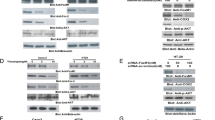Abstract
Background
Inhibition of mammalian target of rapamycin (mTOR) represents an attractive target for anticancer therapy, but its role in suppression of colorectal cancer (CRC) cell growth by cyclooxygenase-2 (COX-2) inhibitors is unclear. Here, we analyzed the effect of indomethacin (Indo, a nonselective COX-2 inhibitor) and nimesulide (Nim, a selective COX-2 inhibitor) on mTOR signaling in CRC cells in vitro and in vivo to determine the dependence of this effect on COX-2.
Methods
Human CRC cell lines with varying COX-2 expression levels were treated with Indo and Nim. Western blot test was performed to detect mTOR-related components (mTOR, p70s6 K, and 4EBP1), and cell viability, cell cycle, and apoptosis were assessed. HCT116 and SW1116 cells were injected into athymic nude mice to establish a CRC xenograft model. After treatment with Nim, tumor volume, mTOR signaling, and apoptosis were evaluated in this model. HT29 and SW1116 cells were also treated with Nim after transfection with COX-2-specific small interfering RNA (siRNA) to assess dependence of COX-2 on mTOR signaling under drug treatment.
Results
Both Indo and Nim reduced mTOR signaling activity in CRC cells that differ in their COX-2 expression in vitro and in vivo. Additionally, Indo and Nim could reduce the mTOR signaling activity after COX-2 silencing in CRC cells.
Conclusions
mTOR signaling is involved in Indo- and Nim-mediated suppression of CRC growth via a COX-2 independent pathway. This study unveils a novel mechanism through which COX-2 inhibitors exerts their anticancer effects and further emphasizes targeting mTOR signaling in anticancer therapy.





Similar content being viewed by others
References
Tsang CK, Zheng XF. TOR-in(g) the nucleus. Cell Cycle. 2007;6:25–9.
Hay N, Sonenberg N. Upstream and downstream of mTOR. Genes Dev. 2004;18:1926–45.
Guertin DA, Sabatini DM. Defining the role of mTOR in cancer. Cancer Cell. 2007;12:9–22.
Tsang CK, Qi H, Liu LF, Zheng XF. Targeting mammalian target of rapamycin (mTOR) for health and diseases. Drug Discov Today. 2007;12:112–24.
Gibbons JJ, Abraham RT, Yu K. Mammalian target of rapamycin: discovery of rapamycin reveals a signaling pathway important for normal and cancer cell growth. Semin Oncol. 2009;36(Suppl 3):S3–17.
Zhang YJ, Dai Q, Tian XQ, et al. mTOR signaling pathway is a target for the treatment of colorectal cancer. Ann Surg Oncol. 2009;16:2617–28.
Zhang YJ, Tian XQ, Sun DF, et al. Combined inhibition of MEK and mTOR signaling inhibits initiation and progression of colorectal cancer. Cancer Invest. 2009;27:273–85.
Sarkar FH, Adsule S, Li Y, Padhye S. Back to the future: COX-2 inhibitors for chemoprevention and cancer therapy. Mini Rev Med Chem. 2007;7:599–608.
Grösch S, Maier TJ, Schiffmann S, Geisslinger G. Cyclooxygenase-2 (COX-2)-independent anticarcinogenic effects of selective COX-2 inhibitors. J Natl Cancer Inst. 2006;98:736–47.
Kashfi K, Rigas B. Non-COX-2 targets and cancer: expanding the molecular target repertoire of chemoprevention. Biochem Pharmacol. 2005;70:969–86.
Jana NR. NSAIDs and apoptosis. Cell Mol Life Sci. 2008;65:1295–301.
Ghosh M, Wang H, Ai Y, et al. COX-2 suppresses tissue factor expression via endocannabinoid-directed PPARdelta activation. J Exp Med. 2007;204:2053–61.
Yamauchi T, Watanabe M, Hasegawa H, et al. The potential for a selective cyclooxygenase-2 inhibitor in the prevention of liver metastasis in human colorectal cancer. Anticancer Res. 2003;23:245–9.
Zhang YJ, Dai Q, Wu SM, et al. Susceptibility for NSAIDs-induced apoptosis correlates to p53 gene status in gastric cancer cells. Cancer Invest. 2008;26:868–77.
Czembirek C, Eder-Czembirek C, Erovic BM, et al. The cyclooxygenase-2 inhibitor nimesulide, a nonsteroidal analgesic, decreases the effect of radiation therapy in head-and-neck cancer cells. Strahlenther Onkol. 2009;185:310–7.
Shaik MS, Chatterjee A, Singh M. Effect of a selective cyclooxygenase-2 inhibitor, nimesulide, on the growth of lung tumors and their expression of cyclooxygenase-2 and peroxisome proliferator- activated receptor-gamma. Clin Cancer Res. 2004;10:1521–9.
Zhang YJ, Zhao SL, Tian XQ, et al. Combined inhibition of Dnmt and mTOR signaling inhibits formation and growth of colorectal cancer. Int J Colorectal Dis. 2009;24:629–39.
Hiraga T, Myoui A, Choi ME, Yoshikawa H, Yoneda T. Stimulation of cyclooxygenase-2 expression by bone-derived transforming growth factor-beta enhances bone metastases in breast cancer. Cancer Res. 2006;66:2067–73.
Parashar B, Shafit-Zagardo B. Inhibition of human neuroblastoma in SCID mice by low-dose of selective Cox-2 inhibitor nimesulide. J Neurooncol. 2006;78:129–34.
Makowski M, Grzela T, Niderla J, et al. Inhibition of cyclooxygenase-2 indirectly potentiates antitumor effects of photodynamic therapy in mice. Clin Cancer Res. 2003;9:5417–22.
Menon S, Manning BD. Common corruption of the mTOR signaling network in human tumors. Oncogene. 2008;27(Suppl 2):S43–51.
Sudarsanam S, Johnson DE. Functional consequences of mTOR inhibition. Curr Opin Drug Discov Devel. 2010;13:31–40.
Dancey JE, Curiel R, Purvis J. Evaluating temsirolimus activity in multiple tumors: a review of clinical trials. Semin Oncol. 2009;36(Suppl 3):S46–58.
Singleton PA, Mambetsariev N, Lennon FE, et al. Methylnaltrexone potentiates the anti-angiogenic effects of mTOR inhibitors. J Angiogenes Res. 2010;2:5.
Efferson CL, Winkelmann CT, Ware C, et al. Downregulation of Notch pathway by a γ-secretase inhibitor attenuates AKT/mammalian target of rapamycin signaling and glucose uptake in an ERBB2 transgenic breast cancer model. Cancer Res. 2010;70:2476–84.
Leng J, Han C, Demetris AJ, Michalopoulos GK, Wu T. Cyclooxygenase-2 promotes hepatocellular carcinoma cell growth through Akt activation: evidence for Akt inhibition in celecoxib-induced apoptosis. Hepatology. 2003;38:756–68.
Ladu S, Calvisi DF, Conner EA, et al. E2F1 inhibits c-Myc-driven apoptosis via PIK3CA/Akt/mTOR and COX-2 in a mouse model of human liver cancer. Gastroenterology. 2008;135:1322–32.
Acknowledgment
This work was supported by grants from the National Natural Science Foundation of China (30900672) and Shanghai Rising Star Program (10QA1404300) to Y.J.Z. and grants from the Shanghai Municipal Education Commission (jdy09074) to Y.J.B.
Conflict of interest
The authors declare no conflict of interest.
Author information
Authors and Affiliations
Corresponding author
Rights and permissions
About this article
Cite this article
Zhang, YJ., Bao, YJ., Dai, Q. et al. mTOR Signaling is Involved in Indomethacin and Nimesulide Suppression of Colorectal Cancer Cell Growth via a COX-2 Independent Pathway. Ann Surg Oncol 18, 580–588 (2011). https://doi.org/10.1245/s10434-010-1268-9
Received:
Published:
Issue Date:
DOI: https://doi.org/10.1245/s10434-010-1268-9




